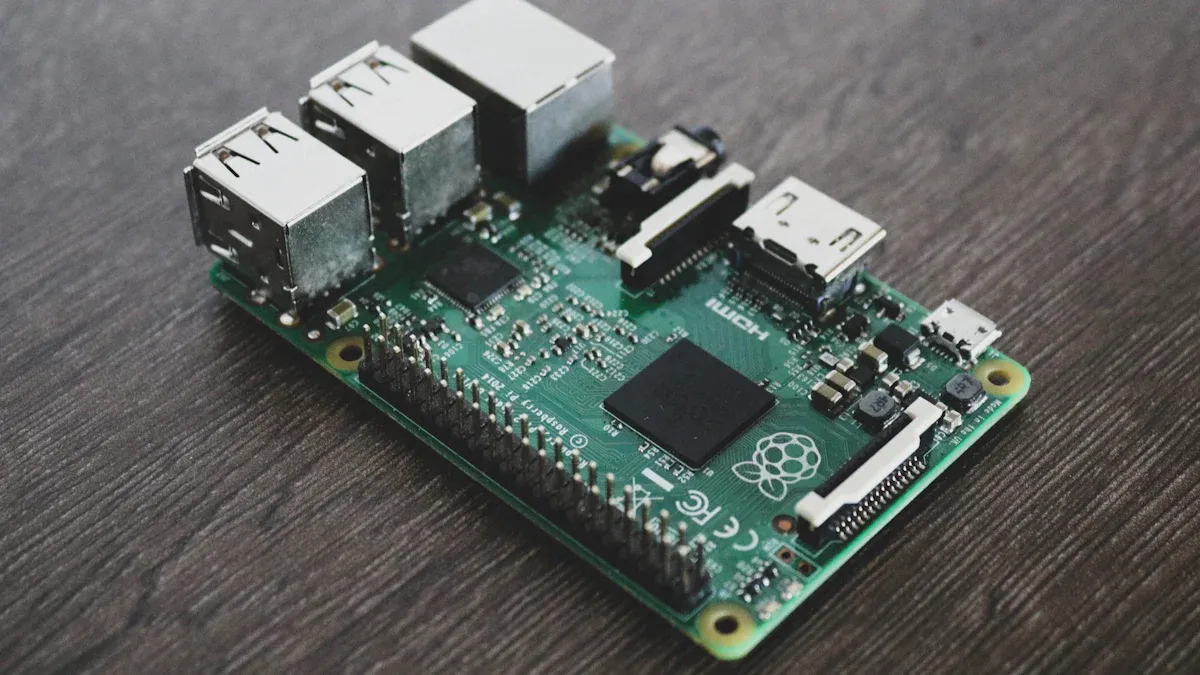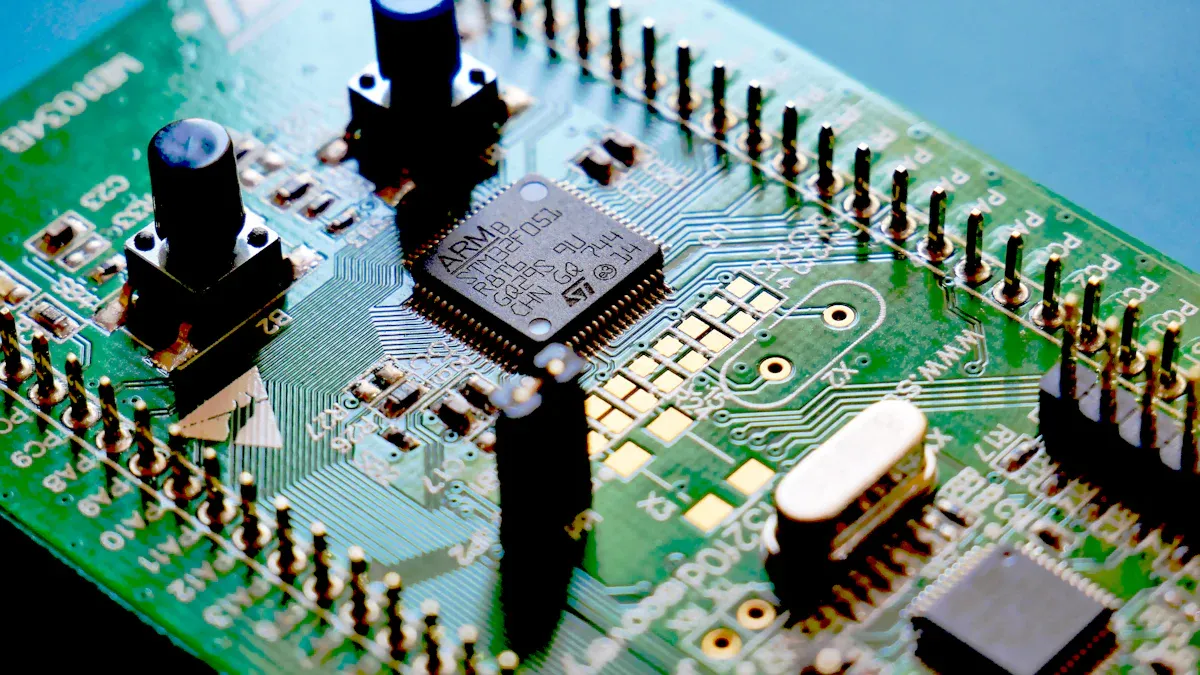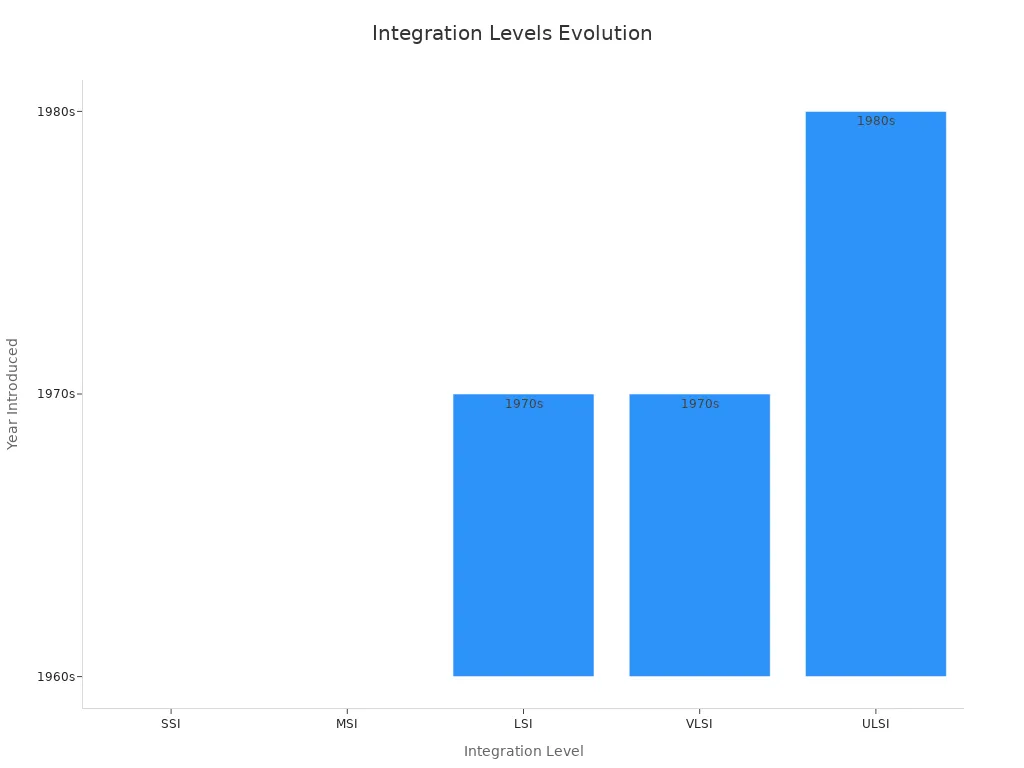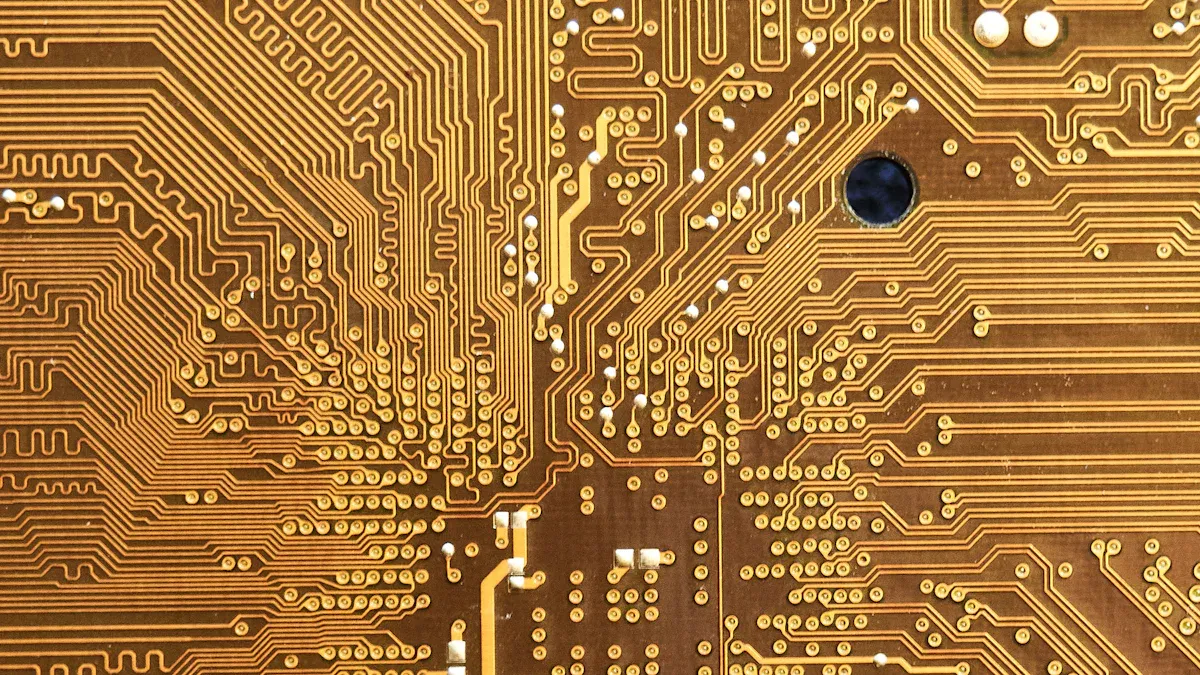Understanding Electronic Digital Integrated Circuits

Electronic digital integrated circuits form the backbone of modern technology. These circuits process binary signals—combinations of 0s and 1s—to perform logical operations and computations. You encounter their impact daily, from the smartphones in your pocket to the communication networks connecting the globe.
📊 The numbers tell a compelling story:
The digital IC market was valued at USD 176.50 billion in 2024, projected to grow at a CAGR of 9.2% to reach USD 554.17 billion by 2037.
Global semiconductor sales surged by 24% in October 2021, generating nearly USD 49 billion.
These circuits are essential for transforming raw data into meaningful outputs, driving advancements across industries like consumer electronics, healthcare, and automation.
Key Takeaways
Digital circuits are important for today’s technology, powering phones and computers.
These circuits use binary signals with parts like transistors and logic gates.
They help devices work better and handle data quickly.
Small designs fit millions of parts on one chip, making devices faster and smaller.
Programmable chips, like FPGAs, can change to fit new uses without replacing them.
Learning about digital circuits shows how they improve everyday gadgets and industries.
What Are Electronic Digital Integrated Circuits?
Definition and Core Components
Electronic digital integrated circuits are compact, highly efficient devices that process binary signals to perform logical operations. These circuits form the foundation of modern electronics, enabling the creation of devices like smartphones, computers, and communication systems. Their development has revolutionized technology, making it possible to integrate millions of components into a single chip.
At their core, these circuits consist of several essential components, each playing a specific role in their functionality. The table below outlines these components and their descriptions:
Component | Description |
|---|---|
Transistors | Fundamental building blocks that control electrical signals. |
Resistors | Components that limit the flow of electric current. |
Capacitors | Devices that store electrical energy temporarily. |
Diodes | Components that allow current to flow in one direction only. |
Logic Gates | Basic building blocks of digital circuits that perform logical operations on binary data. |
Permanent Register | Stores preprogrammed instructions for various operations. |
Temporary Register | Holds numbers to be operated on and the results of operations. |
Counter | Contains the memory address of the next instruction. |
Stack Pointer | Contains the address of the last instruction put into the stack memory. |
Memory Address Register | Holds the location of the data to be worked on. |
These components work together to process data and execute instructions, forming the backbone of electronic digital integrated circuits.
How They Process Binary Signals
Electronic digital integrated circuits process binary signals—combinations of 0s and 1s—by using transistors to control the flow of electrical current. Each transistor acts as a tiny switch, turning on or off based on the input signal. This switching mechanism enables the circuit to perform logical operations, such as AND, OR, and NOT, which are fundamental to computing.
The transition from vacuum tubes to transistors marked a significant milestone in the evolution of these circuits. Transistors, particularly those built using metal oxide semiconductor field effect transistor (MOSFET) technology, allowed for smaller, faster, and more reliable circuits. Today, transistors measure approximately 65 nanometers, enabling millions of them to fit within a single square centimeter. This miniaturization has been pivotal in advancing computing systems and communication technologies.
💡 Did You Know?
The invention of integrated circuits and microchips has driven the evolution of information technology. Innovations in computing often stem from the interplay between competition and cooperation among these elements.
Key Characteristics and Benefits
Electronic digital integrated circuits offer several key characteristics and benefits that make them indispensable in modern technology:
Compactness: These circuits integrate millions of components into a single chip, reducing the size of electronic devices.
Efficiency: They consume less power and operate at higher speeds compared to earlier technologies like vacuum tubes.
Reliability: The use of transistors and advanced materials ensures consistent performance over time.
Versatility: You can find these circuits in a wide range of applications, from consumer electronics to industrial automation.
Scalability: Advances in technology allow for continuous improvements in performance and functionality.
By combining these characteristics, electronic digital integrated circuits have become essential for driving innovation across industries.
Types of Electronic Digital Integrated Circuits
Logic ICs (e.g., Logic Gates, Flip-Flops)
Logic ICs are the building blocks of digital systems. These circuits perform logical operations, enabling devices to process and make decisions based on binary inputs. You’ll find logic gates, such as AND, OR, and NOT, at the core of these ICs. They combine binary signals to produce specific outputs, forming the foundation for more complex operations.
Flip-flops, another essential component, are bistable circuits that store binary data. They toggle between two stable states, making them crucial for memory storage and sequential logic systems. For example, the 7408 logic gate IC is widely used in flip-flop designs, ensuring efficient data storage and retrieval. Designers often rely on prefabricated logic gates from series like TTL 7400 and CMOS 4000, which simplify circuit design and enhance reliability.
🛠️ Tip: Programmable logic devices, such as FPGAs, are increasingly replacing fixed-function logic gates. These devices allow you to reprogram hardware, offering flexibility for evolving applications.
Logic ICs are indispensable in digital systems, managing tasks like arithmetic operations, decision-making, and data storage. Their versatility makes them a cornerstone of modern electronics.
Microprocessors and Microcontrollers
Microprocessors and microcontrollers are the brains of electronic devices. Microprocessors excel at executing instructions and processing data, making them ideal for computing systems. You’ll encounter them in personal computers, laptops, and servers, where high-performance capabilities are essential.
Microcontrollers, on the other hand, integrate a processor, memory, and input/output peripherals into a single chip. They are designed for specific tasks, such as controlling appliances, sensors, or embedded systems. For instance, microcontrollers power devices like washing machines, thermostats, and robotic arms.
Demonstration System | FACSCalibur System | |
|---|---|---|
ADC Dynamic Range | 1,910 bins | 3,000 bins |
Peak Parameter CV | 1.7% | N/A |
Area Measurement CV | 2.3% | N/A |
Resolution | Equivalent | N/A |
The demand for advanced microprocessors continues to grow due to the rise of digital technologies and cloud computing. Microcontrollers, with their compact design and efficiency, remain vital for applications requiring precise control and low power consumption.
Memory ICs (e.g., RAM, ROM)
Memory ICs store and retrieve data, enabling devices to function effectively. RAM (Random Access Memory) provides temporary storage for data that your device actively uses, ensuring quick access and processing. ROM (Read-Only Memory), on the other hand, stores permanent instructions that remain intact even when the device powers off.
Volatile memory types like DRAM and SRAM are popular for applications prioritizing speed, while non-volatile types like flash memory ensure data persistence. Hybrid memory technologies are emerging, combining the benefits of both volatile and non-volatile memory. These advancements indicate a shift toward more versatile memory solutions.
📡 Note: Memory ICs play a critical role in telecommunications, supporting 5G networks by handling increased data traffic efficiently. In the automotive sector, they enable automation and process control, essential for Industry 4.0 and IoT technologies.
Memory interfaces enhance data transfer between memory ICs and processing units, boosting performance in complex devices. Whether in smartphones, industrial systems, or communication networks, memory ICs are integral to modern technology.
Programmable ICs (e.g., FPGAs, CPLDs)
Programmable ICs, such as Field-Programmable Gate Arrays (FPGAs) and Complex Programmable Logic Devices (CPLDs), offer unmatched flexibility in electronic systems. These ICs allow you to customize their functionality after manufacturing, making them ideal for applications where adaptability is crucial. Unlike fixed-function ICs, programmable ICs can be reconfigured to meet changing requirements or to improve performance.
FPGAs stand out due to their ability to handle complex tasks. They consist of an array of programmable logic blocks connected by interconnects that you can configure to perform specific operations. This design enables FPGAs to operate in parallel, significantly boosting performance in tasks like image processing, machine learning, and data encryption. For example, in computational tasks, FPGAs often outperform traditional microcontrollers because they can execute multiple operations simultaneously.
CPLDs, while similar to FPGAs, are better suited for simpler applications. They have a smaller number of logic gates and are easier to program. You might find CPLDs in systems requiring straightforward control logic, such as industrial automation or basic signal processing.
🛠️ Tip: FPGAs can be updated in the field without redesigning the hardware. This feature makes them invaluable in industries where technology evolves rapidly, such as telecommunications and aerospace.
The flexibility of programmable ICs has been validated through technical reviews and factory tests. FPGAs, for instance, can adapt to various applications by being reprogrammed. This adaptability ensures that you can modify or update the hardware without replacing it entirely. Such flexibility is especially beneficial in systems where requirements may change over time.
Application-Specific ICs (ASICs)
Application-Specific ICs (ASICs) are custom-designed chips tailored for specific tasks. Unlike general-purpose ICs, ASICs are optimized for a particular application, making them highly efficient and reliable. You’ll often find ASICs in devices where performance and power efficiency are critical, such as smartphones, medical equipment, and automotive systems.
ASICs excel in specialized environments. For instance, they play a vital role in high-performance X-ray cameras used in groundbreaking studies in chemistry and biology. These chips are also designed to withstand extreme conditions, such as high radiation levels in particle physics experiments or very low temperatures in neutrino research. Their reliability has been proven in space applications as well. ASICs used in NASA’s Fermi Gamma-ray Space Telescope have operated flawlessly for over a decade, showcasing their durability and precision.
💡 Did You Know?
ASICs are often the preferred choice for large-scale production. Their custom design reduces power consumption and enhances performance, making them cost-effective for mass-market products.
The development of ASICs has driven innovation across various fields. In the automotive industry, they enable advanced driver-assistance systems (ADAS) and autonomous driving technologies. In telecommunications, ASICs support high-speed data processing for 5G networks. Their ability to deliver tailored solutions makes them indispensable in modern technology.
How Electronic Digital Integrated Circuits Work

Binary Signal Processing and Logic Operations
Electronic digital integrated circuits process binary signals by executing logic operations. These operations rely on fundamental components like inverters, AND gates, and OR gates. Each component plays a specific role in manipulating binary inputs to produce desired outputs.
Component | Function | Description |
|---|---|---|
Inverter | Converts input signal to opposite output signal | The simplest digital logic device that flips the input value. |
AND Gate | Outputs high only if all inputs are high | Accepts two or more input signals, producing a high output only when all inputs are high. |
OR Gate | Outputs high if any input is high | Produces a high output if at least one of the input signals is high. |
Applications | Used in various devices, from simple switches to advanced computers | Digital logic circuits are essential in both programmable and non-programmable devices. |
These components work together to process binary data, enabling devices to perform tasks like arithmetic calculations, decision-making, and data storage. For example, an AND gate ensures that a specific condition is met before triggering an action, while an OR gate allows flexibility by activating when any condition is satisfied.
Role of Transistors and Circuit Design
Transistors serve as the building blocks of electronic digital integrated circuits. They act as tiny switches, controlling the flow of electrical current based on input signals. By combining millions of transistors, you can create circuits capable of performing complex operations.
Circuit design determines how these transistors interact. Designers arrange transistors into patterns that execute specific functions, such as amplifying signals or performing logic operations. For instance, a NAND gate—a combination of NOT and AND gates—relies on transistor arrangements to produce its output. Advances in circuit design have enabled the creation of smaller, faster, and more efficient circuits, driving innovation in fields like computing and telecommunications.
💡 Fun Fact: Modern transistors measure just a few nanometers, allowing billions of them to fit on a single chip. This miniaturization has revolutionized the performance of electronic devices.
Integration Levels (SSI, MSI, LSI, VLSI)
The evolution of integration levels in electronic digital integrated circuits has transformed technology. Integration levels refer to the number of components embedded on a single chip.
Integration Level | Description | Year Introduced |
|---|---|---|
SSI | Small-scale integrated circuits with a limited number of logic gates, suitable for basic tasks. | 1960s |
MSI | Medium-scale integrated circuits with hundreds of logic gates, balancing functionality and complexity. | 1960s |
LSI | Large-scale integrated circuits integrating tens of thousands of logic gates for complex tasks. | 1970s |
VLSI | Very large-scale integrated circuits with hundreds of thousands of logic gates for high-performance devices. | 1970s |
ULSI | Ultra-large-scale integrated circuits with over a million logic gates for state-of-the-art technologies. | 1980s |

The journey began in the 1960s with SSI and MSI, which integrated tens to hundreds of components. By the 1970s, LSI and VLSI allowed thousands to millions of components on a single chip. The 1980s introduced ULSI, pushing the boundaries of integration to millions of components. This progression has enabled the development of high-performance devices like smartphones and supercomputers.
Applications of Electronic Digital Integrated Circuits

Consumer Electronics (e.g., Smartphones, Laptops)
Electronic digital integrated circuits play a vital role in consumer electronics. These circuits enable devices like smartphones and laptops to perform complex tasks efficiently. You rely on them for faster processing, better connectivity, and compact designs. For example, microprocessors and memory ICs ensure smooth multitasking and quick access to data.
The consumer electronics market has seen remarkable growth due to advancements in integrated circuit technologies. The table below highlights key market trends:
Year | Market Valuation (USD Billion) | Key Insights |
|---|---|---|
2023 | Significant growth expected in consumer electronics due to advanced IC technologies. | |
2032 | 700.00 | Driven by demand for compact and efficient devices, including IoT and smart systems. |
This growth reflects the rising adoption of IoT devices and smart systems. You can expect digital ICs to dominate over analog ICs because of their multifunctionality. Global digitization initiatives and rapid technological transformation further boost their demand.
📈 Note: Challenges like supply chain volatility and rapid advancements in technology require manufacturers to innovate continuously.
Communication Systems (e.g., Routers, Modems)
Communication systems rely heavily on electronic digital integrated circuits to manage data transmission and connectivity. Routers and modems use these circuits to process signals, ensuring stable and high-speed internet connections. You benefit from faster downloads, seamless video streaming, and reliable communication networks.
Digital ICs enhance the performance of communication systems by enabling efficient signal processing and data encryption. For instance, programmable ICs like FPGAs allow real-time adjustments to network configurations, improving adaptability. These circuits also support the growing demand for 5G networks, which require high-speed data handling and low latency.
🌐 Tip: As communication technologies evolve, digital ICs will continue to play a critical role in supporting next-generation networks and devices.
Industrial Automation and Robotics
Industrial automation and robotics depend on electronic digital integrated circuits for precision and efficiency. These circuits control sensors, actuators, and processors, enabling machines to perform tasks autonomously. You’ll find them in applications like predictive maintenance, autonomous vehicles, and robotic arms.
The industrial automation market is expanding rapidly, as shown in the table below:
Metric | Value (2024) | Value (2029) | CAGR (%) |
|---|---|---|---|
Market Size (USD Billion) | 399.12 | 9.3 | |
Role of AI in Predictive Maintenance | Yes | Yes | N/A |
Integration of Autonomous Vehicles | Yes | Yes | N/A |
Digital ICs enable robots to process data in real time, improving accuracy and reducing downtime. For example, ASICs are often used in robotics to optimize performance for specific tasks. The integration of AI with digital ICs further enhances predictive maintenance and decision-making capabilities.
🤖 Fun Fact: Robotics powered by digital ICs are transforming industries like manufacturing, healthcare, and logistics, paving the way for smarter and more efficient systems.
Automotive Electronics
Automotive electronics rely on digital integrated circuits to enhance vehicle performance and safety. These circuits power essential systems like engine control, navigation, and advanced driver-assistance systems (ADAS). You experience their impact every time you drive a modern car, whether through smoother acceleration or improved braking precision.
Electronic control units (ECUs) play a central role in automotive electronics. They use advanced algorithms to optimize engine efficiency and reduce emissions. ECUs also integrate seamlessly with other vehicle systems, such as transmission and braking, to improve overall performance. In electric vehicles, ECUs manage high-voltage tasks and ensure efficient power distribution.
🚗 Note: ECUs are critical for electric vehicles, where managing complex power systems is essential for reliability and safety.
Quality benchmarks validate the reliability of automotive electronics. Compliance with ISO 26262 ensures rigorous safety analysis, reducing the risk of critical failures. Standards like IPC-6012DA enhance the durability of printed circuit boards (PCBs), while AEC-Q100 and AEC-Q200 testing protocols guarantee consistent performance under stress.
ECUs optimize engine performance using advanced algorithms.
ISO 26262 promotes fail-safe systems for safety-critical components.
IPC-6012DA ensures robust PCB manufacturing standards.
AEC-Q100 and AEC-Q200 validate reliability under extreme conditions.
These standards ensure that automotive electronics perform reliably, even in challenging environments. Whether you're driving a traditional car or an electric vehicle, digital integrated circuits make your journey safer and more efficient.
Medical Devices and Equipment
Medical devices depend on digital integrated circuits to deliver accurate and reliable performance. These circuits enable devices like medication pumps, imaging systems, and wearable monitors to function effectively. You benefit from their precision in diagnostics and treatment, which improves patient outcomes.
Integrated circuits enhance the connectivity between medical devices and electronic health records (EHR). This seamless data exchange supports clinical decision-making, helping healthcare providers tailor treatments to individual patients. For example, medication pumps equipped with integrated circuits ensure precise drug delivery, reducing the risk of errors in acute care settings.
🩺 Tip: Integrated devices improve situational awareness for healthcare providers, enabling better patient care.
Clinical studies highlight the importance of integrated circuits in medical devices. They show how these circuits contribute to patient safety by enabling real-time monitoring and data analysis. Integrated systems also enhance situational awareness, allowing healthcare professionals to respond quickly to changes in a patient’s condition.
Medication pumps ensure accurate drug delivery.
Integrated circuits enable seamless data exchange with EHR systems.
Enhanced situational awareness improves individualized patient care.
Digital integrated circuits continue to transform healthcare by powering innovative devices and systems. Whether in hospitals or home care settings, these circuits play a vital role in improving patient safety and treatment precision.
Advantages and Challenges of Electronic Digital Integrated Circuits
Benefits of Compactness and Efficiency
Electronic digital integrated circuits excel in compactness and efficiency, making them indispensable in modern technology. Their ability to integrate millions of components onto a single chip reduces the size of devices while enhancing performance. This compact design allows you to enjoy smaller, more portable gadgets without sacrificing functionality.
Efficiency is another standout feature. These circuits optimize power usage, ensuring minimal energy waste. For instance, digital controllers reduce sensitivity to process variations and decrease reliance on passive components, which enhances overall efficiency. Advanced control strategies like PSM (Pulse-Skip Modulation) significantly lower quiescent current, improving performance at light loads.
Control Strategy | Benefits | Efficiency Impact |
|---|---|---|
Digital Controllers | Reduced sensitivity to process variation, programmability, decreased reliance on passive components | Enhances overall efficiency |
PSM Control | Reduces quiescent current significantly | Improves efficiency at light loads |
PWM, PSM, PFM | Adjusts based on load conditions | Ensures optimal efficiency across diverse loads |
💡 Tip: Lower quiescent current directly reduces power loss. For example, an APSM-based buck converter achieved a quiescent current as low as 0.2 nA, demonstrating remarkable efficiency improvements.
By integrating additional controllers, these circuits achieve ultra-low quiescent currents, ensuring optimal performance even under light loads. This balance of compactness and efficiency drives innovation across industries, from consumer electronics to medical devices.
Limitations and Design Challenges
Despite their advantages, electronic digital integrated circuits face several design challenges. Flexibility in circuit design, while high, has inherent limits. You may encounter constraints that prevent compensations at higher design levels. Performance optimization becomes increasingly critical as complexity grows, requiring careful attention at every stage of development.
Design Limitation | Description |
|---|---|
Flexibility Limits | Despite high flexibility in circuit design, there are inherent constraints in technology that limit compensations at higher design levels. |
Performance Issues | Performance must be addressed at all design levels, with higher-level optimizations being more critical than low-level ones. |
Complexity Management | The design process must avoid introducing errors by freezing system solutions during layout phases. |
Transistors in analog circuits often operate in nonlinear regions, complicating biasing and sizing. This complexity demands both qualitative and quantitative analysis due to the high-dimensional state space of transistors. Additionally, analog IC design automation lags behind digital circuits because it requires personalized reasoning and circuit-level expertise.
⚠️ Note: Managing complexity during the design process is crucial. Freezing system solutions too early can introduce errors, while delaying decisions may lead to inefficiencies.
These challenges highlight the need for innovative approaches in circuit design. By addressing these limitations, you can unlock the full potential of electronic digital integrated circuits, paving the way for even greater technological advancements.
Electronic digital integrated circuits have transformed technology by enabling compact, efficient, and versatile devices. You see their impact in smartphones, medical equipment, and industrial automation. These circuits integrate millions of components into a single chip, driving advancements in computing, communication, and robotics.
Future innovations will rely on breakthroughs in materials science. Better sensors and faster chips will enhance performance. Organic materials will reduce costs and expand manufacturing possibilities. Miniaturized optical devices will revolutionize minimally invasive surgery, creating new opportunities in healthcare.
🌟 Takeaway: Electronic digital integrated circuits are the foundation of modern electronics. Their evolution will continue to shape industries and improve lives.
FAQ
What is the difference between digital and analog integrated circuits?
Digital ICs process binary signals (0s and 1s), while analog ICs handle continuous signals. You use digital ICs in devices like computers and smartphones. Analog ICs are common in audio amplifiers and radio receivers.
How do transistors work in digital circuits?
Transistors act as switches in digital circuits. They control the flow of electrical current based on input signals. When the input is high, the transistor allows current to pass. When low, it blocks the current.
Why are integrated circuits so small?
Integrated circuits are small because they use advanced fabrication techniques. These methods allow millions of components to fit on a single chip. This miniaturization improves performance and reduces power consumption.
Can you reprogram all types of integrated circuits?
No, not all ICs are reprogrammable. Programmable ICs like FPGAs can be reconfigured after manufacturing. Fixed-function ICs, such as ASICs, are designed for specific tasks and cannot be reprogrammed.
What industries benefit the most from digital ICs?
Industries like consumer electronics, healthcare, and automotive benefit greatly. You see their impact in smartphones, medical devices, and electric vehicles. These circuits improve efficiency, reliability, and functionality across various applications.
💡 Tip: Understanding the basics of ICs helps you appreciate the technology behind everyday devices.
See Also
The Importance of Integrated Circuits in Today's Electronics
Fundamentals of Analog IC Design and Its Uses
Exploring IC Line Drivers and Their Functionality in Electronics
